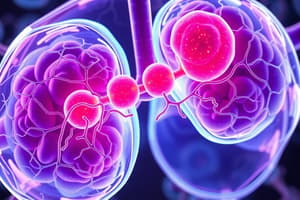Podcast
Questions and Answers
Which of the following processes releases energy to be used by a cell?
Which of the following processes releases energy to be used by a cell?
- Fermentation
- A phosphate group is removed from ATP to form ADP (correct)
- Glucose breakdown
- Photosynthesis
What molecule is represented by the molecular model shown below?
What molecule is represented by the molecular model shown below?
Adenosine triphosphate (ATP)
Removing a phosphate group from an ATP molecule:
Removing a phosphate group from an ATP molecule:
- Releases energy (correct)
- Creates glucose
- Stores energy
- Has no effect
What type of molecule do animal cells use for long-term energy storage?
What type of molecule do animal cells use for long-term energy storage?
Why do cells use fat and starch for long-term energy storage instead of ATP molecules?
Why do cells use fat and starch for long-term energy storage instead of ATP molecules?
Why are cellular processes necessary?
Why are cellular processes necessary?
Explain how energy is recharged.
Explain how energy is recharged.
Why do cells need energy?
Why do cells need energy?
What is the immediate source of energy for cells?
What is the immediate source of energy for cells?
What does a molecule of ATP consist of?
What does a molecule of ATP consist of?
What does a molecule of ADP consist of?
What does a molecule of ADP consist of?
What happens when a phosphate group is removed from ATP?
What happens when a phosphate group is removed from ATP?
What is the energy released from ATP used for?
What is the energy released from ATP used for?
Is ATP used for long-term storage? Why or why not?
Is ATP used for long-term storage? Why or why not?
How do plants store long-term energy?
How do plants store long-term energy?
How do animals store long-term energy?
How do animals store long-term energy?
Explain how ATP can be compared to a rechargeable battery.
Explain how ATP can be compared to a rechargeable battery.
If a cellular process requires a large amount of energy, which organelle will need to be found in greater quantity within the cell?
If a cellular process requires a large amount of energy, which organelle will need to be found in greater quantity within the cell?
What is ADP?
What is ADP?
What is ATP?
What is ATP?
Flashcards are hidden until you start studying
Study Notes
Cellular Energy Overview
- Energy is released when a phosphate group is removed from ATP, converting it into ADP.
- Adenosine triphosphate (ATP) is the primary energy carrier in cells.
Functions of ATP and ADP
- ATP is essential for short-term energy needs and powers cellular processes including movement and protein synthesis.
- When ATP loses a phosphate group, it becomes adenosine diphosphate (ADP), which consists of one less phosphate and retains energy.
Long-term Energy Storage
- Animal cells store long-term energy as fat, while plants use starch and sugar.
- ATP is not suitable for long-term energy storage due to its instability; fat and starch are preferred for this purpose.
Importance of Cellular Processes
- Cellular processes provide the necessary energy for growth, repair, and maintenance of energy balance in multicellular organisms.
- Cells consume energy for various functions, including growth, digestion, transport, and environmental responsiveness.
Energy Recharge Mechanism
- Cells "charge up" ATP using energy from food, similar to how a rechargeable battery operates.
- The energy stored in ATP is released when it converts into ADP, similar to a battery releasing stored power.
ATP Structure
- ATP comprises adenine, a five-carbon sugar (ribose), and three phosphate groups.
- ADP, formed from ATP, includes only two phosphate groups and is produced during energy release.
Energy Demand in Cells
- If a process requires significant energy, the quantity of mitochondria, the cell's powerhouse, must increase to meet the demand.
Summary of Key Terms
- ATP: Main energy source for cellular work.
- ADP: Product of ATP energy release, contains less energy and one less phosphate group.
Studying That Suits You
Use AI to generate personalized quizzes and flashcards to suit your learning preferences.




